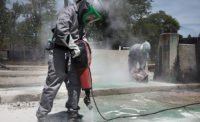Are your guards secure in complying with OSHA?

In an industry where the bottom bid is king, there is simply no margin of error when it comes to protecting profits earned in the security industry. According to a report by the OSHA, a business operating at 2 to 3 percent profit margin must realize sales of products or services totaling $250,000 to generate $5,000 of profit. Numbers like these make it easy to see why the protection of employees and assets is paramount to the industry’s financial health.
Revenues lost paying OSHA fines are just that: Revenues Lost! Yet the Security Industry (SIC 7381) has been cited more than 450 times between June 2004 and June 2009. With OSHA fines averaging $2,300 per citation, these fines total over a million dollars in lost profits.
Guideline for security personnel
Security companies must follow the same regulations as any other business subject to OSHA regulation. Although there are no regulations specific to the security industry, there are several advisories and guidelines. Among these is OSHA Advisory 3335-10N 2007 Preparing and Protecting Security Personal in Emergencies, U.S. Department of Labor, Occupational Safety and Health Administration
Speeding evacuations
The list of possible incidents that security personnel may face is much larger than the worst-case scenarios dreamed by their office managers. However, as far as OSHA is concerned, they must be trained if they are expected to respond. This applies to all workplaces, not just to the larger corporate accounts that sometimes rely on security officers to staff fire brigades or participate in process safety management (PSM) activities.
A well-trained security staff can help to ensure the proper evacuation of employees and the public, speed the response of an emergency response team, and the proper handling of bystanders and representatives of the media. Advisory 3335-10N 2007 provides very specific information on what officers are to be trained and what information they must receive.
Ad hoc responsibilities require training
More than 100 of the OSHA standards require employee training. Some security companies offer voluntary security training over the internet, but few offer the mandatory safety training required by OSHA.
For instance, if security officers are expected to put out small fires, OSHA expects that they will be trained in the use of fire extinguishers annually (1910.157(g)(2).
If they are expected to provide basic first aid or clean-up after accidents involving personnel injuries, they need to be trained in bloodborne pathogens annually 1910.1030(b)(2)(ii).
Many security managers may feel that there is no need for the training because their officers do not perform these tasks. But clients are quick to use contacted officers for a variety of unsavory tasks, and security managers had better make sure their officers and the client completely understand that officers will not perform functions for which they are not trained.
OSHA Publication 2254 lays out many of the subject areas in which an employee should be trained, training methods, record keeping, and guidelines. Security managers should read this publication thoroughly, and pick what portions may pertain to their personnel.
Other OSHA publications include Guidelines for Workplace Violence Prevention of Health Care & Social Services Workers, and Late-Night Retail Establishments (OSHA Publication 3148 and 3153).
Although not specific to the security industry, this publication is pertinent simply because of the nature of security work. Violence inflicted on employees may come from many sources - external parties such as robbers or muggers and internal parties such as coworkers and patients. These guidelines address only the violence inflicted by patients or clients against staff. However, OSHA suggests that workplace violence policies indicate a zero-tolerance for all forms of violence from all sources.
General duty
The Occupational Safety and Health Act of 1970 (OSH Act) mandates that, in addition to compliance with hazard-specific standards, all employers have a general duty to provide their employees with a workplace free from recognized hazards likely to cause death or serious physical harm. OSHA will rely on Section 5(a)(1) of the OSH Act, the “General Duty Clause,” for enforcement authority. Failure to implement these guidelines is not in itself a violation of the General Duty Clause. However, employers can be cited for violating the General Duty Clause if there is a recognized hazard of workplace violence in their establishments and they do nothing to prevent or abate it.
Threat assessments
Security managers usually do a threat assessment for all areas in which they have officers stationed. A worksite analysis involves a systematic, commonsense look at the workplace to find existing or potential hazards for workplace violence. This entails reviewing specific procedures or operations that contribute to hazards and specific areas where hazards may develop. A threat assessment team, patient assault team, similar task force or coordinator may assess the vulnerability to workplace violence and determine the appropriate preventive actions to be taken. Every employee should understand the concept of “universal precautions for violence” - that is, that violence should be expected but can be avoided or mitigated through preparation. Frequent training also can reduce the likelihood of being assaulted.
Limit physical interventions
Employees who may face safety and security hazards should receive formal instruction on the specific hazards associated with the unit or job and facility. This includes information on the types of injuries or problems identified in the facility and the methods to control the specific hazards. It also includes instructions to limit physical interventions in workplace altercations whenever possible, unless enough staff or emergency response teams and security personnel are available. In addition, all employees should be trained to behave compassionately toward coworkers when an incident occurs. The training program should involve all employees, including supervisors and managers.
It's not always the client's problem
Many managers of security guard businesses wrongfully conclude that, if an OSHA violation occurs on the client’s premises, then it is the client’s problem. Wrong! OSHA has a Multi-Employer Citation Policy that, in some instances, allows subcontractors to be cited along with the principle contractor if the subcontractor knew, or should have known, or had employees exposed to a workplace hazard. Although this policy has been challenged in several court decisions, a little proactive knowledge can go a long way in keeping you out of the legal quagmire.
Fatality and injury stats for security officers
According to most recent release from the Bureau of Labor Statistics (June 2009) fatalities among security officers primarily result from Assaults and Violent Acts (60%), Transportation Incidents (21%), Exposures to Harmful Substances and Environments (7%), Falls (6%), and Contact with Objects and Equipment (5%).
Security officers are most likely to incur injuries or illnesses by Falls from the Same Level (26%), Transportation Accidents (14%), Assaults, or Violent Acts (13%), Contact with Object or Equipment (12%), Fall to a Lower Level (8%), Overexertion (7%), and All Other Accidents (15%).
The rate of fatal injuries to security officers was 9.4 fatalities per 100,000 workers in 2007.This was an 8-percent increase from the 2006 rate of 8.7 fatalities per 100,000 workers. The rate in 2007 was more than twice the rate for all workers (3.8) that year.
There were 84 fatal occupational injuries among security officers in 2007, up from an average of 68 fatalities per year from 2003 to 2006. Half of the fatal injuries occurred in the investigation and security service industry and about a fifth occurred in the drinking places industry.
Nevertheless, on-the-job injuries and fatalities of security officers can be a common occurrence. Consider these incidents from the NIOSH FACE program:
CASE STUDY 1: Pancaked by forklift
A 50-year-old California security officer died when he was run over by a heavy-duty industrial forklift used to top load cargo containers. He was directing traffic in the yard at the time of the incident. This was part of his normal duties. The forklift operator did not follow the victim’s traffic directions. The victim had no formal training in traffic control. The CA/FACE investigator determined that, in order to prevent future occurrences, employers, as part of their Injury and Illness Prevention Program (IIPP), should:
- Ensure forklift operators follow the directions of workers directing traffic.
- Consider installing structures that would ensure protection to employees on foot in the area of forklifts.
- Ensure that employees directing traffic have formal training in traffic control
CASE STUDY 2: Fall into frigid river
In the early morning hours of January 25, 1993, a 50-year old, male night watchman was found dead in a Massachusetts river. As part of nightly security checks, the victim was to ensure that tugboat generators remained operational. It is speculated that as he ascended or descended a ladder from the pier to a barge, the ladder dislodged sending him and the ladder into the frigid river. Reporting to work at his appointed time, the tugboat captain found the victim floating face up in the river and immediately summoned EMS and municipal rescue personnel. EMS transported the victim to the regional hospital where he was pronounced dead. In order to prevent similar future occurrences, the Massachusetts FACE Program recommends that employers:
- Provide safe means of accessing docked marine craft;
- Develop, implement, and enforce a comprehensive safety program that includes, but is not limited to, jobsite surveys, written safety procedures for all jobs with potential hazards, and training workers in dockside safety and fall hazard recognition;
- Ensure use of personal flotation devices (PFD) when working near or above water.
CASE STUDY 3: Run over by his own truck
A 55-year-old security officer was killed when he was apparently run over by the pickup truck he had been driving. He was patrolling a municipal power maintenance facility when the incident occurred. He apparently backed into a trailer, damaged the driver side door of the pickup, and then drove the truck approximately 50-60 feet away from the trailer. He apparently got out of the truck and was walking back to the trailer to check for damage when the truck rolled backwards, knocking him to the ground. An employee who was driving by the facility noticed the truck and checked out the incident. He checked the victim and found no pulse or other signs of life. He called 911 who immediately responded.
- The Nebraska Department of Labor investigator concluded that to prevent future similar occurrences employers and employees should:
- Insure vehicle transmission is securely in “park” before exiting the vehicle.
- Insure the vehicle emergency brake is set if the vehicle is left running and unattended.
- Consider requiring vehicle engines to be shut off before exiting vehicles.
Officers trained in safety and OSHA compliance are an asset to the client in that these officers can become an extension, if not the foundation, of the client’s safety and compliance efforts.
Nevertheless, if the number of fatalities and injuries continue to rise, safety training of security officers may come under scrutiny of OSHA in the coming years, and we may see the development of standards and programs more specific to the industry.
Looking for a reprint of this article?
From high-res PDFs to custom plaques, order your copy today!




